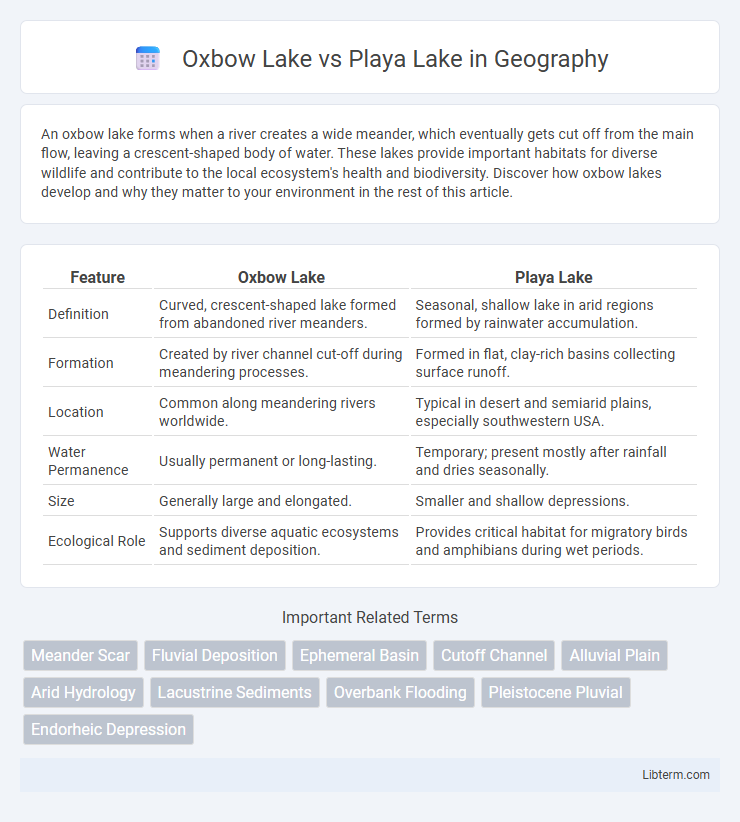An oxbow lake forms when a river creates a wide meander, which eventually gets cut off from the main flow, leaving a crescent-shaped body of water. These lakes provide important habitats for diverse wildlife and contribute to the local ecosystem's health and biodiversity. Discover how oxbow lakes develop and why they matter to your environment in the rest of this article.
Table of Comparison
| Feature | Oxbow Lake | Playa Lake |
|---|---|---|
| Definition | Curved, crescent-shaped lake formed from abandoned river meanders. | Seasonal, shallow lake in arid regions formed by rainwater accumulation. |
| Formation | Created by river channel cut-off during meandering processes. | Formed in flat, clay-rich basins collecting surface runoff. |
| Location | Common along meandering rivers worldwide. | Typical in desert and semiarid plains, especially southwestern USA. |
| Water Permanence | Usually permanent or long-lasting. | Temporary; present mostly after rainfall and dries seasonally. |
| Size | Generally large and elongated. | Smaller and shallow depressions. |
| Ecological Role | Supports diverse aquatic ecosystems and sediment deposition. | Provides critical habitat for migratory birds and amphibians during wet periods. |
Introduction to Oxbow Lakes and Playa Lakes
Oxbow lakes form when a river meander is cut off, creating a crescent-shaped water body often rich in sediment and aquatic life. Playa lakes are shallow, seasonal basins found in arid regions that fill with rainwater and gradually evaporate, leaving mineral deposits behind. Both types of lakes serve as crucial habitats but differ significantly in origin, hydrology, and ecological roles.
Formation Processes of Oxbow Lakes
Oxbow lakes form through the natural meandering and erosion of riverbanks, where a river curve becomes increasingly exaggerated until the neck of the loop narrows and eventually breaks through during a high flow event, isolating the loop from the main channel. This abandoned meander fills with water, creating a crescent-shaped lake confined by sediment deposits that permanently separate it from the river. In contrast, playa lakes develop primarily in arid regions due to surface runoff collecting in shallow depressions with no outflow, relying on evaporation rather than fluvial processes for their formation.
Formation Processes of Playa Lakes
Playa lakes form in arid or semi-arid regions through the accumulation of water in closed basins where evaporation exceeds inflow, causing temporary or seasonal shallow water bodies. Unlike oxbow lakes, which result from the meandering and cutoff of river bends, playa lakes develop primarily from surface runoff and intermittent flooding in flat, low-lying areas with poor drainage. The sedimentation in playa lakes often includes fine clays and evaporites due to high evaporation rates, reflecting their distinctive geomorphological and hydrological formation processes.
Geographic Locations and Distribution
Oxbow lakes predominantly occur in meandering river valleys found across temperate regions such as the Mississippi River basin in North America and the Ganges-Brahmaputra delta in South Asia. Playa lakes are common in arid and semi-arid regions, especially in the southwestern United States, such as Texas and New Mexico, as well as parts of North Africa and Australia. While oxbow lakes form from river meanders in humid environments, playa lakes represent ephemeral, flat-bottomed depressions that collect rainwater in desert landscapes.
Hydrological Characteristics Comparison
Oxbow lakes form from river meanders and exhibit permanent or semi-permanent water bodies with flowing inflows and outflows, supporting diverse aquatic habitats. Playa lakes are shallow, ephemeral depressions primarily fed by surface runoff and rainfall, leading to variable hydrologic conditions with frequent dry periods. The contrasting water retention times and hydrologic connectivity define their ecological functions and sedimentation patterns.
Ecological Significance and Biodiversity
Oxbow lakes, formed from river meanders, provide critical habitats for diverse aquatic species and support rich biodiversity through stable freshwater ecosystems. Playa lakes, temporary and often saline or alkaline, create unique ecological niches that sustain specialized flora and fauna adapted to fluctuating water conditions. Both lake types contribute significantly to regional biodiversity by offering essential breeding grounds, nutrient cycling, and habitat connectivity in their respective landscapes.
Human Impact and Environmental Concerns
Oxbow lakes often face significant human impact from urban development, agriculture, and infrastructure that can lead to pollution, habitat fragmentation, and altered water flow, increasing eutrophication risks. Playa lakes are vulnerable to contamination from agricultural runoff and groundwater depletion, threatening their role in supporting migratory birds and local biodiversity. Both lake types require targeted conservation strategies to mitigate the effects of land use changes, water extraction, and nutrient loading on their ecological integrity.
Seasonal Variations and Water Dynamics
Oxbow lakes exhibit seasonal variations characterized by relatively stable water levels fed by river meanders, often maintaining water year-round due to groundwater input and precipitation. Playa lakes experience significant fluctuations, with water presence primarily during wet seasons or after heavy rainfall, leading to periodic drying during dry months. The water dynamics of oxbow lakes involve slower-moving, more permanent water bodies, whereas playa lakes function as ephemeral basins with rapid filling and evaporation cycles.
Notable Examples Around the World
Oxbow lakes such as the famous Carter Lake in Iowa, USA, are crescent-shaped water bodies formed by the meandering of rivers, showcasing significant fluvial processes. Playa lakes like the Black Rock Desert in Nevada represent ephemeral, flat-bottomed depressions that fill with water seasonally in arid regions around the world. Both types highlight the diversity of lacustrine ecosystems influenced by climate and geomorphology.
Conclusion: Key Differences and Similarities
Oxbow lakes and playa lakes both form in low-lying areas but differ primarily in their formation processes and water sources; oxbow lakes result from river meandering and cutoff, while playa lakes form from temporary rainfall accumulation in arid regions. Both types support unique ecosystems adapted to their specific hydrological conditions, yet oxbow lakes often maintain more stable and permanent water bodies compared to the ephemeral nature of playa lakes. Understanding these distinctions aids in effective wetland management and conservation strategies in diverse climatic and geographic contexts.
Oxbow Lake Infographic

 libterm.com
libterm.com